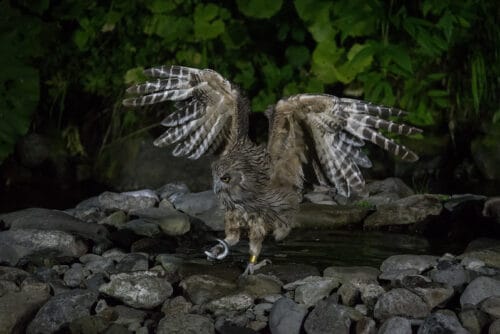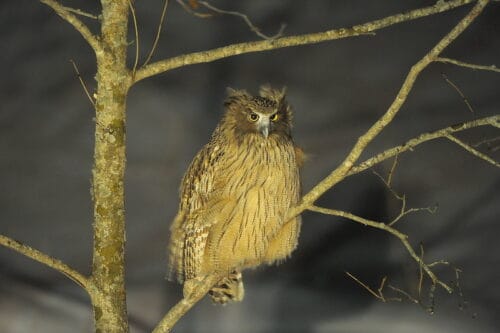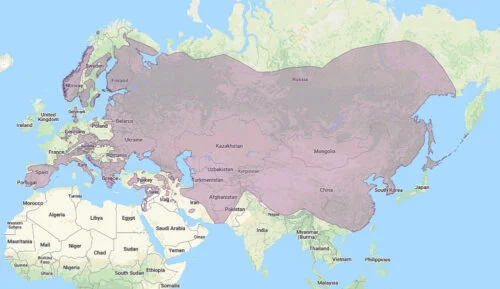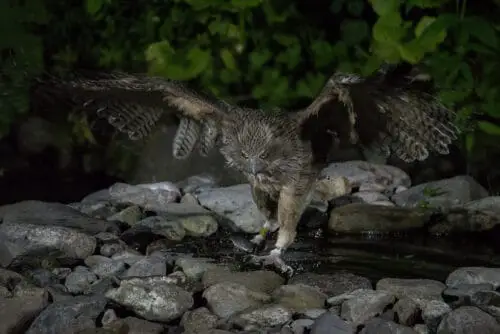The owl with the largest wingspan in the world is the Blakiston’s Fish Owl (Bubo blakistoni), an extraordinary species with an imposing presence and unique adaptations. In this article, we will delve into the key characteristics, habitat, diet, and conservation status of the Blakiston’s Fish Owl, showcasing the world’s largest-winged owl and its importance in the ecosystem.
What is the Owl with the world’s largest Wingspan?

The Blakiston’s Fish Owl holds the title of the owl species with the largest wingspan in the world. These magnificent birds have a wingspan reaching up to 2 meters (6.6 feet). While their body weight is slightly less than the world’s heaviest owl, the Eurasian Eagle-Owl, their impressive wingspan sets them apart from other owl species.
What are the key characteristics of the world’s largest-winged owl?
In addition to their impressive wingspan, the Blakiston’s Fish Owl possesses several unique characteristics:
- Large, dark eyes that offer excellent night vision for hunting
- Plumed ear tufts, giving them a distinctive appearance
- Stout, powerful legs and feet with unique, scaly skin that aids in gripping slippery fish
- Dense, waterproof plumage that enables them to withstand harsh weather conditions and damp environments

Where can the world’s largest-winged owl be found in the wild?
The Blakiston’s Fish Owl has a limited distribution, mainly found in the remote regions of northeastern Asia, including Russia, China, Japan, and North and South Korea. They inhabit dense, old-growth forests near rivers, lakes, and wetlands, which provide them with ample fish to feed on and suitable nesting sites.

How does the world’s largest wing-span owl compare to other large owls?
The Blakiston’s Fish Owl, with its impressive wingspan, stands out among other large-winged owls due to its unique adaptations, specialized hunting technique, and habitat preferences. Here’s how it compares to some other large-winged owls:
- Eurasian Eagle-Owl (Bubo bubo): As the world’s heaviest owl, the Eurasian Eagle-Owl has a wingspan that can reach up to 188 cm (74 inches), making it one of the largest owls. However, its wingspan is still slightly smaller than that of the Blakiston’s Fish Owl. The Eurasian Eagle-Owl has a more diverse diet, feeding on a wide range of prey, including mammals, birds, reptiles, and amphibians, whereas the Blakiston’s Fish Owl primarily preys on fish.
- Great Grey Owl (Strix nebulosa): The Great Grey Owl is another large owl species, with a wingspan that can reach up to 152 cm (60 inches). Although it has a smaller wingspan compared to the Blakiston’s Fish Owl, it is known for its distinct appearance, featuring a large, rounded head with a grey facial disc. The Great Grey Owl inhabits boreal forests and feeds primarily on small mammals, such as voles and mice.
- Great Horned Owl (Bubo virginianus): The Great Horned Owl, which has a wingspan of up to 145 cm (57 inches), is another large-winged owl, though its wingspan is smaller than the Blakiston’s Fish Owl. Its characteristic “horns” or ear tufts, and wide range of habitats across North and South America, make it a well-known species. The Great Horned Owl has a diverse diet, preying on mammals, birds, reptiles, and amphibians.
In summary, while other large-winged owls like the Eurasian Eagle-Owl, Great Grey Owl, and Great Horned Owl possess impressive wingspans and adaptations for their respective habitats, the Blakiston’s Fish Owl stands out with the largest wingspan, unique fish-hunting specialization, and habitat preferences near rivers, lakes, and wetlands.

Are there any specific mating and nesting behaviors unique to the world’s largest-winged owl?
Blakiston’s Fish Owls exhibit some interesting mating and nesting behaviors.
During the mating season, the male owl performs a courtship display, consisting of deep hooting calls, wing-clapping, and displays of its impressive wingspan. Once a pair forms, they engage in mutual preening and share food as part of their bonding process.
These owls prefer to nest in large tree cavities, broken tree trunks, or abandoned nests of other large birds, usually close to water sources.
The female lays 1-3 eggs, which she incubates for around 35 days. The male provides food for the female during incubation.
After hatching, the chicks remain in the nest for about 35-40 days, relying on their parents for food and protection. The young owls leave the nest but continue to receive parental care for several more months.
How does the world’s largest-winged owl hunt and what is its diet?
The Blakiston’s Fish Owl is a highly specialized hunter, with its diet primarily consisting of fish.
They typically hunt at night, using their expansive wingspan and silent flight to glide above rivers, lakes, and other bodies of water.
Once they detect fish near the surface, they swoop down, using their powerful legs and feet to grab the fish from the water.
Occasionally, they may also feed on small mammals, birds, and amphibians.
What is the conservation status of the world’s largest-winged owl and what threats do they face?
The Blakiston’s Fish Owl is currently classified as “Endangered” by the International Union for Conservation of Nature (IUCN) due to its declining population and habitat loss.
The primary threats facing this species include deforestation, habitat fragmentation, river pollution, overfishing, and human disturbance. Climate change could also have long-term effects on the owl’s habitat and prey availability.
